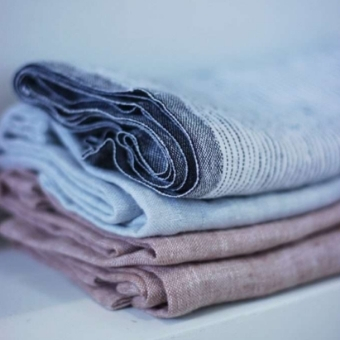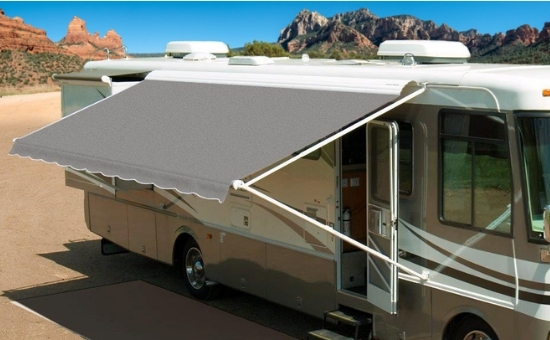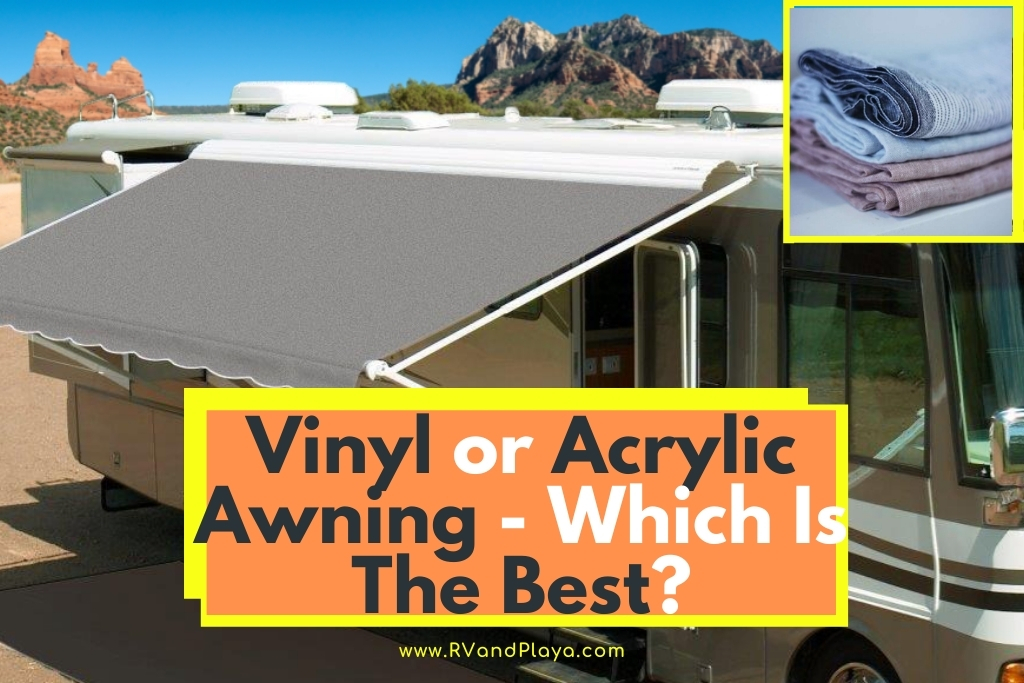If you’re planning a trip using an RV, you’re probably on the lookout for a vinyl or acrylic awning. You may not know which one to look for, or you may be under the impression that they are both the same. If that does indeed apply to you, you are not alone.
What is the better: Vinyl or Acrylic Awning? In windy areas, acrylic awnings are best because they work well against the wind. Vinyl awnings are commonly used in rainy areas because they are waterproof.
However, the answer to this question isn’t as simple as yes or no, and it usually depends on where you will be using it.
In the table below you can find some Pros and Cons:
| Vinyl Awning | Acrylic Awning | |
|---|---|---|
| Pros | WaterproofBudget-friendly | Durable against windBreathableEasy to maintainHolds color well |
| Cons | Mildew can form if not properly maintainedTakes longer to dryLess breathable; hotter | Not waterproofMore expensive |
Like most this or that questions, the answer is much more complicated than you’d like for it to be. There is a lot to consider like usage, wind, temperatures, rain, time management, and storage.
To see how a vinyl or acrylic awning would hold up in the conditions you would have it, read down below.
Table of Contents
What is Best: a Vinyl or Acrylic Awning?
There are pros and cons of both as is the case with everything.
In windy areas, acrylic awnings are best because they work well against the wind. They do not tear easily making them more durable than other materials.
However, where there is wind, there’s a chance you may be up against rain. Though acrylic awnings do repel water, excessive amounts of rain can cause some to seep through.
In most rainy areas, vinyl awnings are preferred because they are waterproof. However, they can easily build up mildew if not maintained properly.
You must maintain and store both awnings properly to keep from needing to replace the awning for as long as possible.
Though acrylic awnings are easily stored and cleaned, it as just as important to keep them clean as it is for vinyl awnings.
Vinyl Awnings
One of the most common types of awning is fabric either coated or laminated in vinyl.
Though they are easy to maintain, they aren’t very flexible which makes them susceptible to tears. If they are in a battle against wind, the wind will usually win.
Vinyl awnings are commonly used in rainy areas because they are waterproof. They can build up mildew easily though so it’s important to take care of it.
You should clean after every trip and let it dry before storing it. You should also deep clean it a few times a year.

If there is any dirt or dust on the awning, mildew can form onto it as well. Besides poor maintenance, high temperatures and humidity can increase the chances of mildew forming onto the awning.
Unlike acrylic awnings, vinyl awnings do not “breathe”, meaning they do not allow moisture to pass through.
This means cooler air doesn’t pass through, and you may notice being hotter while under a vinyl awning. This means you might not want a vinyl awning if you’re going to be traveling in hotter conditions.
Another thing that separates vinyl awnings from acrylic awnings is the lack of colors and patterns within the selection.
When shopping for a vinyl awning, you may find that it is difficult to find the vibrant colors and patterns found in the selection of acrylic awnings.
This is due to acrylic awnings having the colors woven into them, rather than just painted on top. Acrylic awnings are much easier to create patterns on.
When Vinyl Awnings Are Best
There are a few scenarios mentioned above, and one of the scenarios includes vinyl awning’s ability to withhold against water. Along with that, there are times when you’ll want a vinyl, such as:
- Cooler spots, since it is usually hotter under vinyl awnings.
- If you’re on a small budget; vinyl awnings are cheaper.
- Wet climates because vinyl awnings are waterproof.
Acrylic Awnings
Acrylic awnings are made of a woven material that allows it to breathe. This means that air circulates through the awning allowing cooler temperatures under the awning.
The circulation also allows the awning to dry quickly when wet which is useful when referring to time management and maintenance.
In addition to acrylic awnings being breathable due to the woven material, they also hold color better since the color is woven within the awning.
This means your awning can be decorated with a stylish and bright awning for much longer than anyone else who has a vinyl awning.

Since this is the case, acrylic awnings are often used when the owner wants to add the a spunky decor element to an RV.
You can get many designs, ranging from black and white to every color in the rainbow. Using acrylic awnings for these designs is preferred in order to get the most life out of the vibrant colors.
Unlike vinyl awnings, acrylic awnings are not entirely waterproof. However, they are water-resistant.
They can get wet, but excessive amounts of rain can cause it to seep through the woven material which can cause things that don’t need to get wet to be ruined by the rain.
When Acrylic Awnings Are Best
When mentioning scenarios before, acrylics are labeled as the best awning for windy climates.
Below is a list compiled of the best situations for acrylic awnings to be used in:
- Since it is noticeably cooler under acrylic awnings, that makes it perfect for hotter temps.
- If time is something you don’t have, acrylic awnings would be useful due to them being easy to maintain and store.
- If you are looking for an awning where the color will last a long time, this may be the best option.
- Acrylic awnings hold up well against the wind, which can be useful in windy conditions.
Cleaning Your Awning
Speaking of maintenance, it is important to take care of your awning regardless of the fabric.
You should clean both sides of the awning with an awning cleaner after every use. Acrylic and vinyl awnings should be cleaned regularly as the conditions outside can cause dirt and dust to cling to the awning.
Cleaning regularly can prolong the lifespan of your awning.
Get to Shopping!
When shopping for your preferred choice of fabric, remember to always make sure you are buying the best quality awning for you! To avoid buying an awning that is a waste of money, you should buy from the company’s website.
Below are two lists, vinyl and acrylic, that provide 3 awnings each from Shadepro’s website.
Vinyl Awnings
| Product | Link |
|---|---|
| Carefree Eclipse 12V, Electric RV Patio Awning – Vinyl | Click HERE |
| Carefree Fiesta – Vinyl Patio Awning | Click HERE |
| Carefree Freedom – Vinyl Patio Awning | Click HERE |
| Sideout Kover III w/ Full Case- Vinyl | Click HERE |
Acrylic Awnings
| Product | Link |
|---|---|
| Carefree Eclipse 12V – Acrylic Patio Awning | Click HERE |
| Carefree Fiesta LTD – Acrylic Patio Awning | Click HERE |
| Carefree Freedom LTD – Acrylic Patio Awning | Click HERE |
| SideOut Kover III w/ Full Case- Acrylic | Click HERE |
If you have more questions about Shadepro, click HERE for questions and answers about awnings including the difference between vinyl and acrylic awnings.
You may find some of the questions and answers through that link useful as you look for the right awning for you.
What is Best Vinyl or Acrylic Awning? Now You Know
When choosing the best awning for you, you must consider the conditions you will be having it in. If you will be in windy conditions, the durability of an acrylic awning would be beneficial for you.
If you will be in rainy conditions, a vinyl awning can be beneficial to you due to it being waterproof.
How Long Do Canvas Awnings Last?
How long do canvas awnings last? As a general estimate, the lifespan of a canvas awning may be anywhere from 5 to 15 years, depending on the maintenance, care, and the conditions in which the awnings are kept.
Early canvas awnings were made from linen or hemp, but modern canvas awnings are mostly cotton based. Canvas is durable, but it must be treated to resist water damage.
To extend the lifespan of your awning, you need to regularly clean the fabric. The canopy endures temperature extremes, rain, and airborne pollutants like dirt, grease, leaf tannins, insects, and bird droppings. When dirt gets into the weave, it can encourage mold growth.
Moisture and compounded pollutants can lead to fabric mildew, which shortens the lifespan of your awning significantly.
Retractable awnings are more expensive but are not exposed as often to elements when not in use and suffer less sun and weather damage and tend to last longer than non-retractable awnings.
Are Awnings Waterproof?
Are awnings waterproof? Most awnings offer some measure of water resistance, but not all awnings are waterproof. Laminated or coated vinyl is strong and waterproof and easy to maintain, but they are susceptible to tears and don’t function well in windy areas.
Vinyl coated fabrics offer good water resistance, but their plastic appearance and limited lifespan don’t make them the best awning option.
Solution-dyed acrylic is composed of colorless fibers that are dyed in acrylic pigments that are woven into cloth.
This type of waning material is highly fade resistant as well as being highly water-resistant. They are also resistant to mold and mildew growth and are relatively easy to clean.
Some popular brands that offer solution-dyed acrylic are Sunbrella and Recacril, Sattler, and Dickson.
Will Bleach Hurt A Vinyl Awning?
Because many vinyl awnings have specialized coatings, it is essential to use the correct cleaning solutions to prevent damage to the coating and your waning’s lifespan. Ideally, you would find a specialized vinyl cleaner, such as 303 multisurface cleaner, endorsed by both Sanbrella and Dickson.
Will bleach hurt a vinyl awning? Some DIY RVers claim that bleach won’t do any harm to your awnings, but you can lose your warranty from certain awning manufacturers, and even though it looks clean, you may be shortening your vinyl awnings lifespan.
If you want the most extended wear out of your vinyl awning, it is always safer to use vinyl-specific cleaning products.
If bleach is the only cleaner at hand, ensure you dilute the solution well ( ¼ cup bleach, ¼ cup soap to 5 gallons water,) and rinse the area properly after washing.
How Far Do RV Awnings Extend?
How far do RV awnings extend? Although there are sites that claim to provide retractable awnings over 14 feet or longer, Ed Kough of Easternawning Systems advises that although awning width can extend to 40 feet, the distance that the awning projects from the arm should not exceed 14 feet.
Over 14 feet would require additional side and front supports to just one lateral arm.
Larger manual awnings can be a real bother to fold and extend on the go and would also be suited to more manageable dimensions.
How Do I Waterproof My RV Awning?
Waterproofing or re-waterproofing your RV awning is a reasonably straightforward process.
How do i waterproof my RV awning? To waterproof your RV awning, follow the steps below:
Step#1: First clean and dry your awning and protect the surrounding area from waterproofing spills.
Step#2: Find the best waterproofing solution suitable to your awning material and place the solution in a spray bottle to save time.
Step#3: Coat your awning according to the waterproof instruction you have chosen and ensure that you follow their guidelines. Impatience in drying time, for example, could cost you money in the long term.
Best for Vinyl Awnings
Star Brite Waterproofer has a dry time of 6 hours and offers heavy-duty protection for fabrics, vinyl, and materials exposed to high water contact.
Made for the marine industry, it still suits outdoor fabrics such as awnings and tents. It can be bought in a 22-ounce bottle suited to the average size awning.
Best for Fabric Awnings
303 Fabric Guard is your best bet for fabric, natural fibers, and synthetics. It is excellent protection from bad weather and helps restore water resistance lost over time from weather and washing.
It will not interfere with your awning colors, inflammability, or breathability. 303 is not suited to vinyl, rubber, or leather. Dry time is 6 to 12 hours.
Frequently Asked Questions
Here are a few common questions people often have about Awnings:
How Much Does It Cost To Replace An RV Awning?
How much does it cost to replace an awning? On average you can expect between $500 for small awning up to $4500 for large one. However, replacing your RV awning is price dependent on several variables.
The material and the mechanics and size of your chosen awning type affect your price considerably.
For example, a small 2’ x 3’ manual awnings would cost you about $500, while a large 6’ x 15’ motorized awning could cost you around $3,500.
If you are handy with tools, you could shave off a decent amount for labor.
How Much Wind Can An RV Awning Withstand?
How much wind can an RV awning withstand? As a rule of thumb, most awnings can sustain a certain amount of wind, but when the wind hits over 20 MPH, it’s time to manually or mechanically retract your awning.
You should keep in mind that Irregular gusts can be far more damaging to your awning that a constant wind.
Supported awnings can withstand greater wind speeds as they have several brackets independent of each other and often have ‘weather kits’ that include tension creating elastic straps attached to the lead rail for security.
Theoretically, this kind of warning system can go beyond the 25MPH wind limit, but it seems counter-intuitive to take the chance.
Are Retractable Awnings Worth It?
Retractable awnings can cost you more than 3,500 dollars when a fixed awning of the same size can easily cost you a quarter of that amount.
Are retractable awning worth it? Yes, retractable awnings prove their worth over time, protecting the awning fabric from the effects of the elements. They also protect your furnishings from the sun and weather damage and can save you money in AC bills in summer.
Their longevity mediates the initial costs and makes a retractable awning a worthwhile long-term investment.
Recommended Reading
For more helpful articles about RVing please check out our articles below:
10 Tips and Tricks How to Remove A Slide-Out Out of a Camper
How Much Wind Can a Pop Up Camper Take? Is It Dangerous?
How to Compare Travel Trailers: A Comprehensive Step-by-Step Guide
Travel Trailer vs. Toy Hauler: 17 Differences That Matter
How to Choose the Perfect Cover for Your Travel Trailer [Read This First]
What is a Non-ducted RV Air Conditioner? (Ducted vs. Non-ducted)
Recent Posts
Is Toyota Remote Connect Free? (Subscription, Services Plans)
Does Toyota Remote Connect have an included trial? It used to be the case that, when you bought a new car, you made one straightforward payment and that was it. Now, it feels like there are...
Toyota Safety Connect: What It Is And Why You Need It? Whether you’re buying a new Toyota or you’ve had one for a while you will have been given the hard sell on their Connected Services but do...

